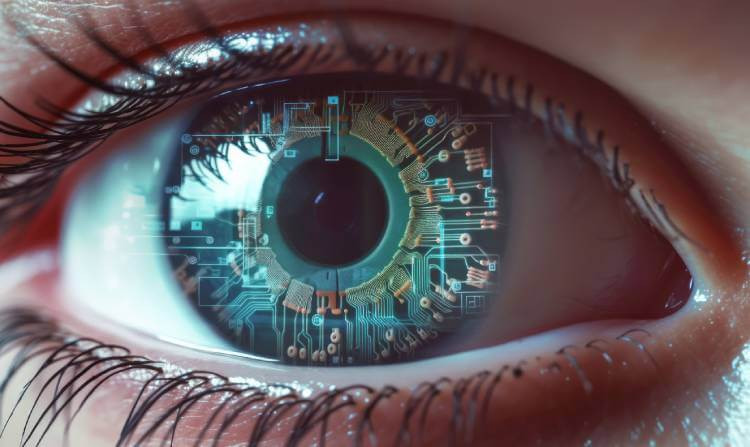Wafer-Scale 2D Perovskite Oxides in Motion Recognition Systems
Technical Analysis | 10-12-2024 | By Liam Critchley

2D semiconductor materials have shown a lot of promise in advanced optoelectronic systems—such as machine vision, neuromorphic visual systems, and in-sensor computing architectures—with 2D perovskite oxide showing high optoelectronic performance in photodetection applications. While there is a lot of potential for these materials, they currently require harsh synthesis processes to produce the devices, which often generates defects that limit the performance of the device and make it difficult for large-scale wafer integration. Researchers have now tried a new approach to developing wafer-scale 2D perovskite oxide optoelectronics for motion recognition applications.
Key Things to Know:
- 2D perovskite oxides offer high optoelectronic performance, particularly in ultraviolet (UV) photodetection applications.
- Traditional fabrication methods for 2D perovskite oxides involve harsh synthesis processes that often lead to defects, limiting device performance and scalability.
- A new charge-assisted oriented assembly film-formation process enables wafer-scale integration, significantly reducing defects while enhancing device reliability and efficiency.
- This breakthrough paves the way for motion recognition technologies with exceptional accuracy, showcasing the potential of 2D perovskite oxides in machine vision and flexible electronics.
Interest in 2D Perovskite Oxides for Optoelectronics
2D perovskite oxides are wide bandgap semiconductors that have unique physiochemical properties that govern a high optoelectronic performance, particularly for ultraviolet (UV) photodetection. 2D perovskite oxides possess properties that are characteristic of 2D perovskite materials, such as a high photoconductive gain, tuneable bandgap, and efficient carrier extraction. However, many 2D perovskites can be unstable, but 2D perovskite oxides are not. The unique benefit of 2D perovskite oxides is their ability to capture UV photons and the UV detection performance—as many 2D semiconductor materials are tuned to have very small bandgaps for capturing visible and infrared (IR) light.
Issues with 2D Perovskite Oxide Fabrication
As it stands, large-scale integration is more favoured for other 2D semiconductors than it is for 2D perovskite oxides. Many 2D semiconductors are compatible with large-area fabrication methods and can be integrated into photonic circuits and microelectronics. However, the harsh synthesis conditions and defect chemistry associated with 2D perovskite oxide fabrication means that it has been difficult to achieve large-scale fabrication and wafer-scale integration with a controllable thickness. On top of this, current fabrication routes create a persistent photoconductivity effect from traps in the material, causing the devices to have a slow response speed. There also needs to be some balance between responsivity and response speed for these devices.
New Wafer-Scale Integration Approach
Researchers have now developed a new approach that allows for wafer-scale integration of 2D perovskites through a charge-assisted oriented assembly film-formation process. This process allowed for wafer-scale integration of functional 2D perovskite oxide nanosheets with a controllable thickness.
Beyond enabling wafer-scale integration, the charge-assisted oriented assembly film-formation process significantly minimises defects commonly associated with large-scale fabrication. This reduction in defects ensures better carrier transport efficiency and improved photodetector performance, making the devices more reliable for advanced optoelectronic systems. Additionally, the process aligns with environmentally sustainable practices by utilising less harsh synthesis conditions compared to conventional methods.
Balancing Performance with Shallow-Trap Dominance
This fabrication created a device with highly ordered nanosheets and a shallow-trap dominance. These shallow traps provided the device with a much faster response speed compared to other 2D perovskite oxide photodetectors and perovskite UV devices, as well as a photosensitivity that is close to the performance of a single nanosheet—striking a balance between the two characteristics that have traditionally had to undergo a trade-off.
The achievement of this balance has broader implications for future applications. By combining high photosensitivity with faster response speeds, these devices pave the way for real-time monitoring in medical diagnostics and industrial automation. The stability provided by shallow-trap dominance also positions these devices as frontrunners in wearable technology and flexible electronics, where durability under varying conditions is paramount.
Demonstrating Versatility in Motion Recognition
The researchers used the 2D perovskite oxides to create an ultra-flexible 256-pixel device to demonstrate the versatility of the material-to-substrate integration of this new approach. This new device was used in motion recognition applications and was used to capture multi-directional motion trajectories with an accuracy of over 99.8%. This was due to the ability of the device to output high-quality single frames for spatiotemporal processing. On top of this, a convolutional neural network (CNN) was used to improve the accuracy of the motion images.
This impressive motion recognition accuracy highlights the device's potential for next-generation machine vision systems. Applications could extend to autonomous vehicles, where precise trajectory detection is critical, or to robotics, enhancing interaction capabilities through real-time spatial awareness. Furthermore, the integration with convolutional neural networks (CNNs) underscores the synergy between advanced hardware and artificial intelligence, opening avenues for adaptive and predictive technologies in dynamic environments.
Breaking Down Barriers in Wafer-Scale Integration
Overall, the new approach has created a new fabrication strategy that enables 2D perovskite oxide materials to be integrated at the wafer scale without the fabrication issues and potential property trade-off issues that are often seen with 2D perovskite oxide fabrication and device integration. It’s one step closer to using 2D perovskite oxides in advanced optoelectronic and microelectronic systems.
By addressing these long-standing challenges, the fabrication strategy not only resolves technical limitations but also lowers the barrier for scaling up production. This is especially important for industries seeking cost-effective solutions for high-performance optoelectronics. Future research could focus on refining this method further to enable compatibility with broader device architectures, such as hybrid photonic circuits or multi-functional sensor arrays.
Contributing to Sustainability Goals
These advancements also contribute to the global push for more energy-efficient technologies. The low energy requirements of 2D perovskite-based devices, combined with their high performance, align well with sustainable development goals. As the technology matures, its adoption could significantly reduce the environmental impact of large-scale manufacturing in the electronics industry.
How The Device Creates Images for Motion Recognition
A conventional machine vision system uses light-sensing and current-stimulation function modules to create images, with the performance and optimisation of the light-sensing modules is critical for motion recognition and motion prediction functions. A high photosensitivity and fast response speed of the individual photodetector/photosensors is also key for ensuring that the device is capturing high quality single frame images.
The device created by the team generates single-frame images based on motion trajectories. The device captures images when a target object moves in the local vicinity of the sensor, and the pixels in the sensor capture a light signal from the moving object. This causes a current change in the device, which simulates visual stimulations. Using the information encoded in the current change allows single-frame images to be outputted by the device that contains temporal information. The approach to encoding information in the image is different from that of conventional photodetectors. Weighting photoresponse currents by time allowed temporal information to be encoded into the image, which provided motion trajectory images with spatiotemporal information.
All photodetectors follow a process of activation and recovery when a photon hits the device. The sensitivity of all photodetectors is governed by the control process that governs how quickly the device returns to its natural state after photon illumination. Devices that take longer to return to their natural state possess more residual electronic signals, so there’s a persistent visual perception of an object. However, in this device, the pixels are activated and rest quickly, so this is not an issue.
When there is motion in front of the device, the activated pixels generate electrical signals, but the inactivated pixels are immediately restored to their natural state. By overlapping the frames from the time-weighting information, the spatial information can be merged from the time points that each individual pixel captures to capture the motion trajectory of an object. With multiple frames overlapping, the CNN helps to better model the combination of data to produce a more accurate output, with the CNN improving accuracy in all 8 spatial directions measured in the tests. The 99.8 accuracy of the device is also a lot much higher than the control device (without CNN), which only has an accuracy of 60%, so many design aspects had to come together to make efficient 2D perovskite oxide optoelectronics a reality.
Reference:

